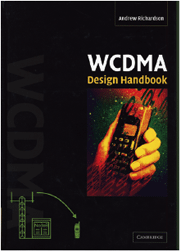
WCDMA Design Handbook
Andrew Richardson
Cambridge University Press • 590 pages; $100
This book addresses the subject of wideband code division multiple access (WCDMA) as defined by the Third Generation Partnership Project (3GPP) and provides a detailed review of the architecture and the operation of the system. The focus is on the radio interface, from the physical layer through to the upper layers of the non-access stratum. This text offers a complete end-to-end explanation of the system operation, or alternatively allows the reader to focus on any aspects of the system, which are of interest and relevance. The material is presented in a modular fashion, with the overlap and interlinking of the chapters kept to a minimum to allow them to be as self-standing as possible. The book can be divided into four parts. Part 1, Chapters 1 to 3, is a general introduction; Part 2, Chapters 4 to 7, covers mainly the physical layer; Part 3, Chapters 8 to 12, covers layers 2 and 3 in the access stratum; and Part 4, Chapters 13 and 14, covers the non-access stratum protocol. The reading of these four parts will depend upon the specific interests of the reader. Parts 1 and 2 are recommended for RF, DSP, ASIC and hardware engineers. For protocol designers/software designers and protocol test engineers who are focusing on the operation of the access stratum of the WCDMA system, Parts 1 and 3 are the most appropriate. Protocol designers/software designers and protocol test engineers concentrating on the operation of the non-access stratum of the WCDMA system should read Parts 1 and 4. Finally, for an interested reader, or for a graduate or undergraduate course, the chapters can be taken in order. The book follows the 3GPP specifications; for completeness, the relevant specifications are outlined in the Appendix.
To order this book, contact:
Cambridge University Press 40 West 20th Street
New York, NY 10011-4211
(212) 337-5057

Classic Works in RF Engineering: Combiners, Couplers, Transformers and Magnetic Materials
John L.B. Walker, Daniel P. Myer, Frederick H. Raab and Chris Trask, Eds.
Artech House • 382 pages; $129, £55
Much of the groundbreaking developments of RF components occurred in the 1940s and many of these components still form the backbone of today’s designs. The original work is hard to find as it was published in journals that are long gone or had limited circulation. The aim of this book is to make this wealth of information readily available. It focuses on passive signal processing components commonly used at RF, namely impedance conversion and power splitting/combining. Chapter 2 looks at the history of powdered iron materials before considering ferrite materials that use the oxides of magnetic materials, followed by a discussion on losses in magnetic materials caused by eddy currents and hysteresis, and concludes with noise and distortion considerations. Chapter 3 on baluns/hybrids/anti-phase power splitters initially discusses the distinction between these terms before detailing the fundamental performance limitations associates with this type of component. It continues with a description of lossless, two- and three-port baluns including the lattice (bridge), Marchand and Guanella baluns, and concludes with lossy three-port and lossless four-port baluns. Chapter 4 is concerned with impedance transformation and shows that, at RF, this is best done using a transmission line transformer. It concludes with a discussion on design, construction and application. Chapter 5 begins by discussing the basic terminology and then develops the theory of hybrid splitters and hybrid combiners. Chapter 6 describes quadrature combining of power amplifiers, a system otherwise known as a balanced amplifier. This chapter also considers aspects that are not normally addressed, such as the effect of arbitrary loads on the overall performance.
To order this book, contact: Artech House
685 Canton St.
Norwood, MA 02062
(781) 769-9750 ext. 4030; or 46 Gillingham St.
London SW1V 1HH UK
+44 (0) 207-8750
